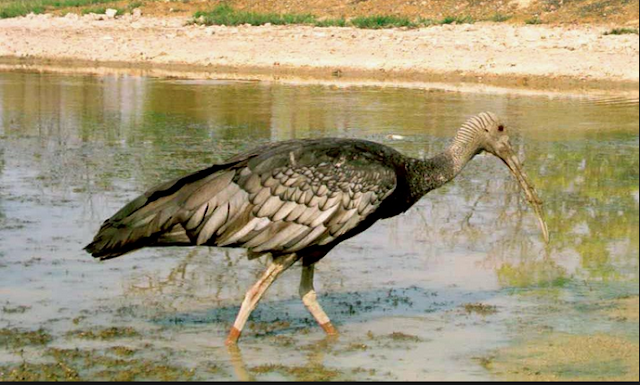The giant ibis (Thaumatibis gigantea), the only species in the monotypic genus Thaumatibis, is a wading bird of the ibis family, Threskiornithidae.
It is confined to northern Cambodia, with a few birds surviving in extreme southern Laos and a recent sighting in Yok Đôn National Park, Vietnam.
The giant ibis is a lowland bird that occurs in marshes, swamps, lakes, wide rivers, flooded plains and semi-open forests as well as pools, ponds and seasonal water-meadows in denser deciduous forest.
One bird was collected in a Malay paddyfield. Formerly the giant ibis was believed to breed in southeastern Thailand, central and northern Cambodia, southern Laos and southern Vietnam.
It was still fairly common in the Mekong Delta until the 1920s but is now almost depleted, with a small remnant population breeding in Cambodia, southern Laos and possibly in Vietnam.
This is, by far, the largest of the world's ibises. Adults are reportedly 102–106 cm (40–42 in) long, with an upright standing height of up to 100 cm (39 in) and are estimated to weigh about 4.2 kg (9.3 lb).
Among standard measurements, the wing chord is 52.3–57 cm (20.6–22.4 in), the tail is 30 cm (12 in), the tarsus is 11 cm (4.3 in) and the culmen is 20.8–23.4 cm (8.2–9.2 in).
The adults have overall dark grayish-brown plumage with a naked, greyish head and upper neck.
There are dark bands across the back of the head and shoulder area and the pale silvery-grey wing tips also have black crossbars.
The beak is yellowish-brown, the legs are orange, and the eyes are dark red. Juveniles have short black feathers on the back of the head down to the neck, shorter bills and brown eyes.
It has a loud, ringing call, frequently repeated around dawn or dusk, a-leurk a-leurk.
Very little is known of the giant ibis's life history. It eats aquatic invertebrates, eels, crustaceans and small amphibians and reptiles.
Insects such as locusts and cicadas are eaten regularly when abundant and seeds occasionally supplement the diet. Outside of the breeding season, frogs and mole-crickets appear to be perhaps the most significant prey types for giant ibises.
They mainly forage in muddy substrate in shallow waters, though can feed at all depths in seasonal forest pools. Feeding flocks may consist of a breeding pair or small family group and have been observed mixing with black ibises. Next to nothing is known of its breeding behaviour, but it nests in trees, with a possible preference for Dipterocarpus trees. Usually, nests are located at least 4 km (2.5 mi) from human habitations, although the species is not especially shy around or fearful of humans unless persistently harassed or hunted. Females lay two eggs at the start of the rainy season, around June to September. Earthworms taken from their mounds in wet grasslands appears to be an important food source for nesting ibises of this species. In general, the species is residential but can wander widely for food or in response to disturbances. The giant ibis is generally territorial and may remain with a family group throughout the year. However, in the dry season, when they are not nesting, groups of up to seven individuals, sometimes likely unrelated, have been observed feeding together.
Followers
Popular Posts
-
The Bayon is an extraordinary and luxuriously brightened Khmer sanctuary at Angkor in Cambodia. Implicit the late 12th or mid 13th century a...
-
The island of Singapore was known to sailors in any event by the third century A.D. By the seventh century, when a progression of sea states...
-
Structure the essential area of industry of the Japanese economy, together with the Japanese mining industry, however together they represen...
-
The Jungle temple of Beng Mealea is the one beautiful temple in Angkor area that it's was built by king Suryavarman II(the great khme...
-
Australia is a nation, and mainland, encompassed by the Indian and Pacific seas. Its real urban areas – Sydney, Brisbane, Melbourne, Perth, ...
Designed By Templateism | Seo Blogger Templates









